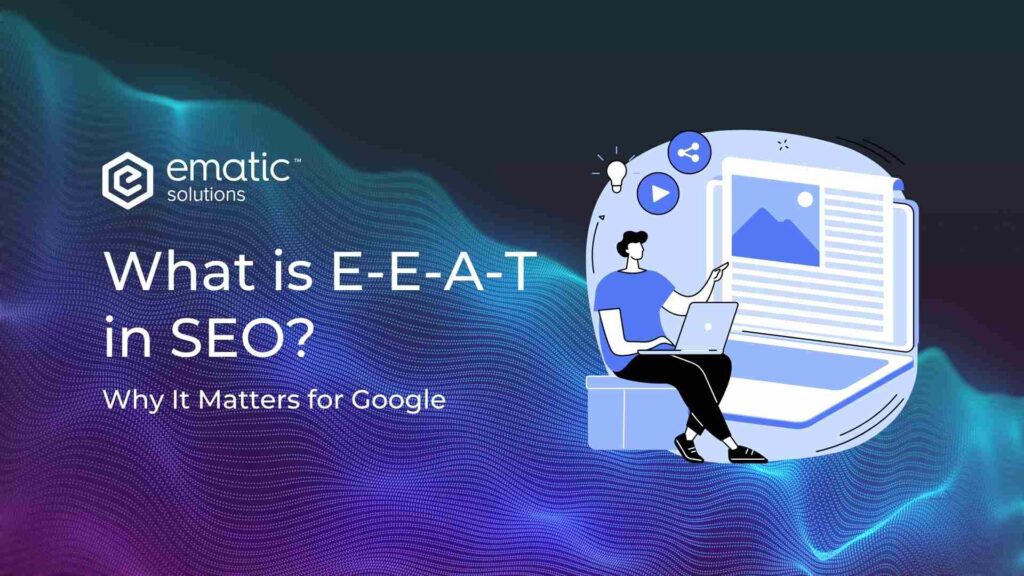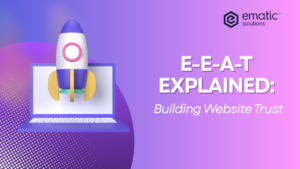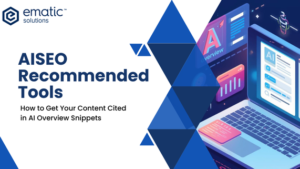If you’ve ever wondered why some websites consistently rank at the top of Google while others struggle to appear on the first page, the answer often comes down to trust. Google doesn’t just look at keywords or backlinks anymore. It wants to know if your content is genuinely helpful, credible, and written by someone who knows what they’re talking about. That’s where E-E-A-T comes in.
What Does E-E-A-T Stand For?
E-E-A-T stands for:
- Experience – Has the content creator personally experienced the topic they are writing about?
- Expertise – Does the content show a high level of knowledge or skill in the subject matter?
- Authoritativeness – Is the website or author known as a go-to source in the field?
- Trustworthiness – Is the content reliable, accurate, and safe for users?
This framework helps Google assess the overall quality of a webpage, especially for topics where misinformation can have serious consequences like health, finance, or legal content.
What Is E-E-A-T Used For?
E-E-A-T is not a direct ranking factor, but it’s a key concept in Google’s Search Quality Evaluator Guidelines, which are used by real human evaluators to assess search results.
Here’s what E-E-A-T helps Google determine:
- Content Quality: Is the information valuable and accurate?
- Credibility: Is the source trustworthy and well-regarded?
- Safety: Can users rely on this content for important decisions?
It’s especially relevant for YMYL (Your Money or Your Life) pages which are those that impact users’ well-being, finances, or safety.
How to Use E-E-A-T in SEO?
Building E-E-A-T into your SEO strategy takes time and effort. Here are concrete ways to apply the framework to your website:
1. Showcase Real-World Experience
People trust content that feels real. If you’ve personally used a product, gone through a process, or solved a specific problem, share that story. Firsthand experience makes your content more relatable and believable.
To boost that trust factor, include original photos, videos, or step-by-step guides, especially for reviews, tutorials, or how-tos. Real visuals add authenticity.
You can also highlight customer stories, testimonials, or case studies. These show that your advice or product has made a real difference for real people.
2. Demonstrate Expertise
To show expertise, your content should be written or reviewed by someone with verifiable knowledge of the topic. This could be a certified professional, industry expert, or someone with deep hands-on experience.
Make it easy for readers (and Google) to see this by adding detailed author bios that include credentials, professional affiliations, or links to LinkedIn profiles. Supporting your points with relevant research, data, or case studies reinforces your expertise and helps the content stand up to scrutiny.
3. Build Authoritativeness
Being seen as a trusted voice in your niche takes time, but it pays off. If your brand is mentioned by other reputable sites, cited in articles, or earns backlinks, it signals that others trust your insights.
You can grow this authority by guest posting, forming partnerships, or getting quoted in industry publications. Consistency matters too: keep your content fresh, reliable, and aligned with your brand’s tone so visitors see you as a go-to source.
4. Establish Trustworthiness
Trust is everything online. Start with the basics—make sure your site is secure (use HTTPS) and easy to navigate. Let visitors know who’s behind the content by adding a clear About page, author info, and contact details.
Also, be upfront with policies like privacy, returns, and shipping as it builds confidence.
And don’t forget to keep your content accurate and up to date, especially if you cover important topics like health, money, or legal advice. Updating your content regularly shows your commitment to giving users safe, reliable information.
Real-Life Application: How E-E-A-T Affects Different Industries
Let’s look at how it plays out in various website types:
| Website Type | Experience Example | Expertise Indicator | Authority Signal | Trust Feature |
|---|---|---|---|---|
| Health Blog | Personal health journey | Written by a certified health coach | Linked from health forums | Medical disclaimers, cited studies |
| Financial Services | Case studies or client results | Credentials like CFA or CPA | Featured in finance media | Secure site, regulatory disclosure |
| E-commerce Store | Product use demo or reviews | Product knowledge in descriptions | High ratings, known brand | Clear return policy, secure checkout |
| Beauty Brand | Founder story or user testimonials | Input from haircare professionals | Featured in beauty publications | Ingredient list, dermatologist-tested |
What Is the E-E-A-T Level?
While it is not scored with a public “level” or numeric value, Google’s evaluators use it as a qualitative measure to assess:
- Low: Thin, unoriginal, misleading, or spammy content.
- Moderate: Average content with basic information but little authority.
- High: In-depth, original, credible content from known experts or brands.
- Very High: Content created by true subject-matter experts with proven experience, heavily cited by other trusted sources.
This is especially important for YMYL topics, where very high E-E-A-T is expected to ensure user safety and well-being.
Why Is E-E-A-T Important for SEO?
Here’s how it can impact your rankings and user engagement:
✓ Improves Ranking Potential
- Google favours pages that demonstrate trustworthy expertise.
- High-E-E-A-T content is more likely to appear in featured snippets and top results.
✓ Builds Long-Term Authority
- Sites that consistently demonstrate E-E-A-T tend to gain domain authority over time.
✓ Enhances User Trust
- Clear bios, accurate content, and transparent policies improve user confidence and reduce bounce rates.
✓ Helps You Withstand Algorithm Updates
- Sites with strong scores are less likely to suffer during Google core updates.
How to Increase Your Website’s E-E-A-T Score?
Here’s a checklist of tactics you can apply today:
✅ Content & Experience
- Write about topics you or your contributors have direct experience with.
- Use real photos, screenshots, or user examples.
✅ Author Transparency
- Include detailed author bios with credentials.
- Add publication dates and update content regularly.
✅ Site Trust Signals
- Use SSL certificates (HTTPS).
- Display contact info, privacy policy, and return/refund policies clearly.
✅ Reputation Building
- Encourage positive reviews and testimonials.
- Pursue partnerships or guest posts with high-authority sites.
- Get cited by reputable media sources.
Is E-E-A-T Still Relevant in 2025?
Yes, more than ever. As Google continues to fight misinformation and reward quality, the framework remains central to how it assesses content reliability. In fact, with the rise of AI-generated content, Google is increasingly prioritizing authenticity and human insight which ties directly to E-E-A-T, especially the Experience element added in 2022.
In 2025, it plays a vital role in:
- Combating AI-generated spam.
- Surfacing trustworthy sources for health, news, finance, and legal topics.
- Supporting ethical brand storytelling in commerce and lifestyle industries.
Final Take: E-E-A-T Is Not Optional
E-E-A-T isn’t just an SEO buzzword. It’s a reflection of how Google evaluates quality, credibility, and user trust. If your goal is to rank well in Google and build long-term digital presence, then weaving the framework into your content and brand strategy is a must.
It’s not about gaming the system, but it’s about earning your place in search results by being genuinely helpful, trustworthy, and experienced in what you do.
Want to Know More About SEO? Contact Us Now for a Free Website Audit!




